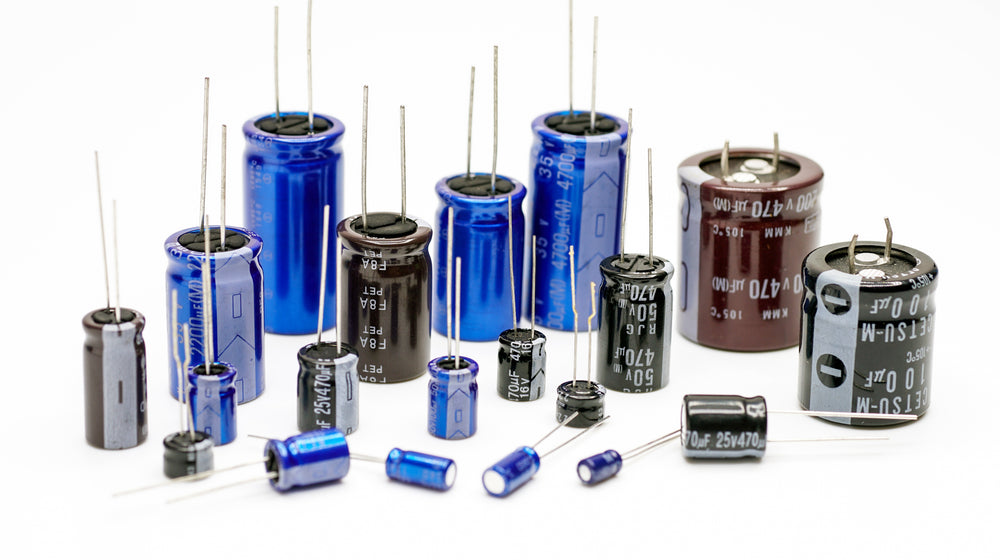
8 Applications of Capacitors
Capacitors are essential components in modern electronics, offering versatile applications across various fields. From energy storage and power conditioning to precise tuning and signal processing, capacitors ensure the efficient and reliable operation of your devices.
In this article, our team at BCB Sales & Service delve into capacitors' various applications, explaining how they work, the different types available, and their specific uses in everyday technology.
What is a Capacitor?
A capacitor is a two-terminal passive electrical component that stores electrical energy. Within are two metal plates separated by an insulating material known as a dielectric. Capacitors are used in various applications to store and release electrical energy, stabilise voltage and power flow, and filter signals.
How Do Capacitors Work?
Capacitors work by storing electrical charges on their metal plates when applying an electric current. The dielectric material between the plates prevents the charges from directly crossing to the opposite plate, creating an electric field and storing energy in the process. When the circuit provides a path for the charges to move, the stored energy is released.
The amount of energy a capacitor can store depends on the surface area of the plates, the distance between them, and the type of dielectric found within.
What are the Different Capacitor Types?
When it comes to capacitors used in motors, there are two main types:
Run Capacitors
These capacitors provide continuous electrical energy to the motor while it is running. They help improve the motor's efficiency by maintaining a consistent voltage supply, ensuring smooth and reliable operation. Run capacitors are commonly used in HVAC systems, compressors, and other machinery requiring stable performance over extended periods.
Start Capacitors
Start capacitors provide an initial boost of energy to the motor at startup. They deliver a higher voltage than run capacitors, helping the motor overcome initial resistance and start turning. Once the motor reaches a certain speed, the start capacitor typically disconnects from the circuit. These capacitors are essential in applications that require high starting torque, such as air conditioners, refrigerators, and heavy-duty equipment.
The Many Applications of a Capacitor
1. Energy Storage
Capacitors are frequently used for energy storage due to their ability to temporarily hold electrical charges, acting as a temporary battery. In electronic devices and uninterruptible power supplies, capacitors can maintain the power flow during outages or while batteries are replaced, preventing data loss. In car audio systems, for example, capacitors store energy and release it when we activate the amplifier, ensuring a consistent power supply.
2. Coupling
In capacitive coupling, capacitors connect different circuit sections by blocking DC signals and allowing AC signals to pass through in applications like loudspeakers, where DC currents can cause damage. By using capacitors, these circuit sections can communicate without the risk of DC interference.
3. Decoupling
Decoupling capacitors play a crucial role in protecting sensitive microchips from electrical noise within a circuit. They absorb noise generated by other circuit elements, ensuring stable power delivery to the microchips. These capacitors are typically placed between the power supply and the ground to maintain a clean power signal.
4. Power Conditioning
Capacitors help stabilise energy levels by smoothing out current fluctuations, thereby ensuring a consistent power supply. They act as a reserve for DC power sources and can bypass AC currents, helping to reduce noise and separate different parts of the circuit, such as in audio equipment, where they divert power line hum.
5. Sensors
Capacitors are excellent for sensing applications because they react to changes in external factors such as humidity, fuel levels, and mechanical strain. Their added sensitivity makes them particularly valuable in detecting variations in capacitance. When these factors change, either the distance between the capacitor plates or the state of the dielectric alters. Capacitors are also utilised in motion detectors to enhance circuit timing accuracy.
6. Power Factor Correction
Capacitors can operate in power factor correction, improving energy efficiency by adjusting the power factor and switching them in and out of the circuit. Doing so helps to counteract the inefficiencies caused by inductive loads from electric motors and transmission lines, ensuring you only use the required amount of power.
7. Tuning
Variable capacitors are essential in tuning circuits, particularly in radio systems. The capacitor charges and discharges at specific intervals when used with an LC oscillator. If these intervals match the frequency of a nearby broadcast, the radio receiver can pick up the signal, facilitating precise tuning.
8. Signal Processing
Capacitors are vital in signal-processing applications. In Dynamic Random Access Memory (DRAM) devices, capacitors store energy to represent binary data. The device reads the stored value based on whether the capacitor is charged or discharged. Charge-coupled devices (CCDs) also rely on capacitors to represent information, but they do so in an analogue format, enabling the processing of different types of signals.
Explore Our Comprehensive Selection of Capacitors Available Online
Discover the perfect capacitor for your needs with our extensive online selection at BCB Sales & Service. Whether you're looking for run capacitors, start capacitors, or specialised models for unique applications, we have the right products to enhance your electrical systems.
Browse our capacitor collection today or contact our friendly team for more information.
